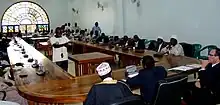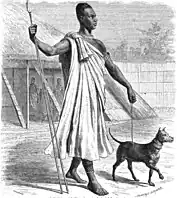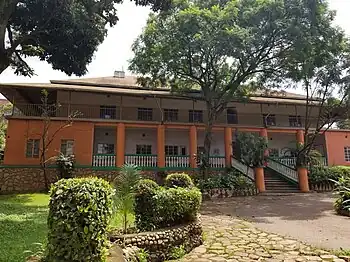Uganda Muslim Supreme Council
The Uganda Muslim Supreme Council (UMSC) is the chief organization for governing and representing Islam in Uganda.[1] The UMSC was founded in 1972 to bring together the divided Muslim community in Uganda. It is currently led by Sheikh Shaban Mubaje, who serves as the Mufti of Uganda.
 UMSC leaders engaged in debate | |
| Abbreviation | UMSC |
|---|---|
| Formation | June 1, 1972 |
| Headquarters | Kampala Hill |
| Location | |
Mufti of Uganda | Shaban Mubaje |
1st Deputy Mufti of Uganda | Abdallah Ssemambo |
2nd Deputy Mufti of Uganda | Muhammad Ali Waiswa |
| Website | http://umsc.or.ug/ |
Organization
Initial Constitution (1972)
The first UMSC constitution was drafted in 1972 at a religious conference organized by Ugandan dictator Idi Amin. This constitution stated that the organization would be led by a Supreme Council of eleven representatives from Uganda's 21 civil administrative districts. Any male Muslim in Uganda would be eligible to run or vote for this role. This council would serve for five year terms and was mandated to meet at least once a year. At their first meeting, the council would elect the Chief Kadhi (later called Mufti)[2] and his deputy, the Chairman of the Executive Council, the Secretary General, and two administrative bodies that would serve for a five year term: The Executive Council and The College of Sheikhs.[3]
The Executive Council would be responsible for handling the administrative tasks of the entire organization and would be led by the Chairman, Chief Kadhi, Secretary General, and 11 other nominated members. The College of Sheiks would be the utmost authority on all religious matters for the Muslim community of Uganda and would be composed of the Chief Kadhi, his deputy, 21 district Kadhis, and a few elected Sheiks. There would also be a Council of Representatives composed of representative of all district counties and led by a district Kadhi.[4]
This first constitution had several issues including equal district representation for districts with large variations in Muslim populations, lack of demarcation of responsibility amongst the newly created administrative bodies, and ambiguity regarding the relationship between the UMSC and the government.[4]
Initial constitutional amendments (1982 & 1986)
The UMSC constitution was amended in 1982 and 1986. The second constitutional amendment was handled by Nsambu and Lubega Advocates, a law firm in Kampala.[2][5]
Latest constitution amendment (2022)
The last time that the UMSC constitution was amended was on 13 July 2022.[6] The UMSC said that this constitutional amendment aimed to address the needs of previously excluded groups, such as women, youth, and the elderly, and large structural changes that have elapsed since the last amendment in 1986.[7][5] Despite the previous constitution stating that amendments can only be added by an independent committee appointed by a General Assembly, the latest amendments were added by a 21 person team led by former Secretary General Edris Kasenene.[6]
The constitutional amendments primarily dealt with the required qualifications to run for Mufti. The maximum age cap was raised from 70 to 75, the candidate must have a Master's degree in Sharia and Secular education, and they would be eligible to run for a second 10 year term after their first term. Additionally, the amended constitution changed the election process such that the Mufti would be elected by the 22 member College of Sheiks as opposed to previously where they were appointed by the 230 member General Assembly.[6]
The qualifications to become Mufti in the amended constitution are as follows:[6]
- A Ugandan Sunni male Muslim
- Between 40 and 75 years old
- Holds at least a Master's Degree in Sharia and Secular Education or their equivalents
- Fluent in both Arabic and English
- Following the footsteps of the Prophet Muhammad
- Respectable, properly married, and a good practicing Muslim
- Possesses a clean track record free from offenses under the National and Islamic laws
- 10 years of working experience in a Muslim leadership position
- Serves a 10 year renewable term
History
Early Muslim organizations in Uganda

The first authorities for the Islamic faith were rulers of the Kingdom of Buganda. The 30th Kabaka of Buganda Muteesa I (r. 1856–1884) was the first Kabaka to convert to Islam and claimed to be "the head of (the) Islamic religion". One of his sons, the 33rd Kabaka of Buganda Kalema (r. 1888–1889) personally oversaw religious affairs and consulted a committee of religious scholars of differing faiths on religious matters. A prince of the Buganda, Nuhu Mbogo Kyabasinga rescinded his claim to the throne to become a leader for Muslims under the British administration of the Protectorate of Uganda. Through working directly with British colonial administrators and the christian majority of Uganda, Mbogo was widely recognized as the utmost authority on the governance of Islam in Uganda.[9]
Authority over the Muslim community was contested upon his death in 1921 by two organizations: one centered in Butambala and another in Kibuli. The Butambala faction was supported by Apollo Kaggwa and composed of the chiefs of Butambala under the leadership of Twaib Magatto and Abdullah Ssekimwanyi. The Kibuli faction was led by Prince Badru Kakungulu, upon nomination by the 34th Kabaka of Buganda Daudi Chewa II, and other Muslim leaders.[10] While initially the two organizations only differed in leadership, gradual doctrinal differences that arose between the two led to the creation of more Muslim organizations. The two organizations split into the Uganda Muslim Community headquartered at Kibuli, the Zukhuli sect headquartered at Kawempe, and the African Muslim Community Natete-Bukoto over disagreements regarding performing the Friday Zuhr prayer. These three organizations coexisted with cordial competition until the founding of the National Association for the Advancement of Muslims (NAAM) in 1965, which sought to move the center of Islam away from Buganda, which the three fiercely opposed. Aside from these four organizations, other smaller groups were founded for specific groups. The Uganda Muslim Students Association for students, the Youngmen's Muslim Association for young men, and five groups representing muslim Asian Ugandans: Khoja Shia Ishnasir Jamat, Dawoodi Bohara Jamat Corporation, Dawoodi Bohora Limited, Muslim Sunni Association, and the Aga Khan Ismailia Community.[11] All of these groups acted independently and had their own constitutions until Idi Amin organized a religious conference in Kabale in May and June of 1971 to resolve the differences between the several religious communities in Uganda.[12]
Creation of the UMSC

The UMSC was officially inaugurated on 1 June 1972 to much support by Muslims in Uganda and abroad. Prince Badru Kakungulu donated 20 acres of land to the organization and relinquished his role as the leader of the Uganda Muslim Community, the largest Muslim organization in Uganda up until that point. The organization also received large donations from Saudi Arabia, Libya, the Central African Republic, and individual donors. The UMSC quickly became the richest landlord in Uganda after purchasing a large estate from George Franck Walusimbi Mpanga, the mayor of Kampala, and inheriting land belonging to the Asian Muslims expelled from Uganda. This land acquisition enabled the UMSC to move their headquarters from the Basiima House, the former private residence of Apollo Kaggwa, to the Kampala Jamatkhana mosque.[13]
In 1973 and 1974, Uganda was admitted into the Organisation of Islamic Cooperation under representation by the UMSC and they contracted a Muslim company to build them a new mosque and headquarters.[14]
Challenges faced by the UMSC
In 1975, without regard to the bureaucratic processes laid out in the UMSC constitution, the Ugandan government ousted the first Chief Kadhi Sheikh Maulana Abdul Razak Matovu and replaced him with Sheikh Yusuf Sulaiman Matovu. Amin dismissed Matovu a year later, which left the UMSC without a leader. From 1975 to 1979, the UMSC would be administered by Acting Secretary General Ahmad Mufanjala but under de-facto control of Idi Amin who handled major decisions. Under fear of questioning Amin's authority, the UMSC failed to follow many of the responsibilities outlined in their constitution.[15]
In 1979, Idi Amin's regime was toppled and Muslims in Uganda faced intense persecution and violence due to their religion. Many Muslims, including most of the senior leadership of the UMSC, went into hiding or fled Uganda entirely to escape discrimination. Almost all government officials wanted to dismantle the UMSC, which was seen as a remnant of Amin's dictatorship, and return the administration of the Islamic community to the previous Muslim organizations. The Muslim leader Prince Badru Kakungulu was consulted on how Uganda's Muslim community should be administered and entrusted to find a solution with the Uganda Muslim Community organization in Kibuli. While Prince Badru felt that the UMSC should be maintained and reformed for better operation, the Muslim leaders he worked with wanted to dismantle the UMSC and work through the previous organizations.[16] Prince Badru called a meeting of 50 Sheiks and asked them to nominate a temporary leader amongst themselves until a stable election could formally be done. The Sheiks instead presented Prince Badru with three Sheiks that he could choose from: Ssemakula, Abdulzaak Matovu, and Kassimu Mulumba. Prince Badru chose Kassimu Mulumba and his two delegates as temporary leaders of the UMSC due to Mulumba's fluency in both Arabic and English and having underwent both Western and Quranic education.[17]
Price Badru worked with his former rival Sheikh Abdu Kamulegeya, the leader of NAAM and many non-Baganda Muslims, to organize a press conference to announce the temporary leadership and discourage division in Uganda's Muslim community. The two agreed that the UMSC must be preserved and that Mulumba and his two deputies would be installed as the temporary leaders of the UMSC for a three month period until the Muslims of Uganda could vote for new UMSC leaders according to the constitution. This press conference would be held in the UMSC headquarters and Kamulegeya would reassure his followers of this decision. After the press conference was held, Prince Badru became the Chairman and Kamulegeya became a prominent member of a temporary three month Executive Council.[18]
Following the establishment of this temporary administration, the UMSC was able to functionally operate as an organization again. From May to December 1979, the organization began to reappoint district Kadhis and organized a 1000 person pilgrimage of Ugandan Muslims to Mecca. Resentment towards the temporary leadership began to grow as they had overstayed their three month term and new elections hadn't yet been organized, which led the UMSC to begin the process of deciding how to elect permanent officials. A UMSC task force led by Asumani Mbuubi and Sulaiman Kigunda collected data from various districts around Uganda on how elections should be conducted and in July of 1980 began organizing elections.[19]
While elections were occurring, the government warned Muslims against introducing politics into their religion. This prompted acting Cheif Kadhi Mulumba to suspend sections in the 1972 constitution that dealt with elections and expel the acting Executive Council and Secretary General.[19] The Executive Council responded by dismissing the Chief Kadhi and calling a meeting of the newly elected Supreme Council members at Makerere University. This new Supreme Council elected Sheikh Abdu Kamulegeya as the Chief Kadhi, which led to more conflict and confusion as there were now two Chief Kadhis for Ugandan Muslims. A mediator from the Muslim World League got the two groups within the UMSC who were loyal to either Chief Kadhi to resolve their differences and agree to preserve the legitimacy of the UMSC constitution. They agreed to maintain the UMSC leadership elected at Makerere in order to prevent new elections from being held, affirmed Mulumba as the Chief Kadhi and made Kamulegya his deputy, and incorporated some of Mulumba's loyalists in the UMSC leadership.[20]
Leadership
| № | Portrait | Mufti | Term | Notes | Ref |
|---|---|---|---|---|---|
| 1 | Maulana Matovu | 1972 – 1974 | [21] | ||
| 2 | Yusuf Matovu | 1974 – 1978 | Directly nominated by Idi Amin instead of the Supreme Council as stated in the 1972 Constitution. | [21] | |
| 3 | Kassim Mulumba | 1979 – 1983 | Personally chosen by Prince Badru Kakungulu. | [21] | |
| 4 | Abdu Kamulegeya | 1983 – 1985 | [21] | ||
| 5 | Kassim Mulumba | 1985 – 1986 | Mulumba's 2nd term. | [21] | |
| 6 | Hussein Kakooza | 1986 – 1991 | [21] | ||
| 7 | Saad Luwemba | 1991 – 1997 | [21] | ||
| 8 | Muhammad Semakula | 1997 – 2000 | [21] | ||
| 9 | Shaban Mubaje | 3 December 2000 – current | [21][6] |
References
- "Uganda Muslim Supreme Council (UMSC)". Inter-Religious Council of Uganda. 2019-05-03. Retrieved 2023-10-12.
- Independent, The (2022-07-14). "UMSC general assembly sets term limits for office of the mufti". The Independent Uganda. Retrieved 2023-10-12.
- Kasozi 1985, p. 40-41.
- Kasozi 1985, p. 41.
- Homeland Media Room (2022-02-02). "The Homeland Newspaper". The Homeland Newspaper. Retrieved 2023-10-25.
- "Muslim top organ changes constitution amid protest". Monitor. 2022-07-15. Retrieved 2023-10-12.
- "Uganda Muslim Supreme Council embarks on journey to amend their constitution". New Vision. Retrieved 2023-10-15.
- Kasozi 1985, p. 36.
- Kasozi 1985, p. 37-38.
- Kasozi 1985, p. 38.
- Kasozi 1985, p. 38-39.
- Kasozi 1985, p. 40.
- Kasozi 1985, p. 41-42.
- Kasozi 1985, p. 42.
- Kasozi 1985, p. 42-43.
- Kasozi 1985, p. 43-44.
- Kasozi 1985, p. 44-45.
- Kasozi 1985, p. 45-46.
- Kasozi 1985, p. 46.
- Kasozi 1985, p. 47.
- "Wall of Fame - UMSC". 2023-04-25. Retrieved 2023-10-12.
Bibliography
- Kasozi, Abdu B.K. (1985). "The Uganda Muslim supreme council: an experiment in Muslim administrative centralisation and institutionalisation, 1972–82". Institute of Muslim Minority Affairs. 6 (1): 34–52. doi:10.1080/13602008508715923.